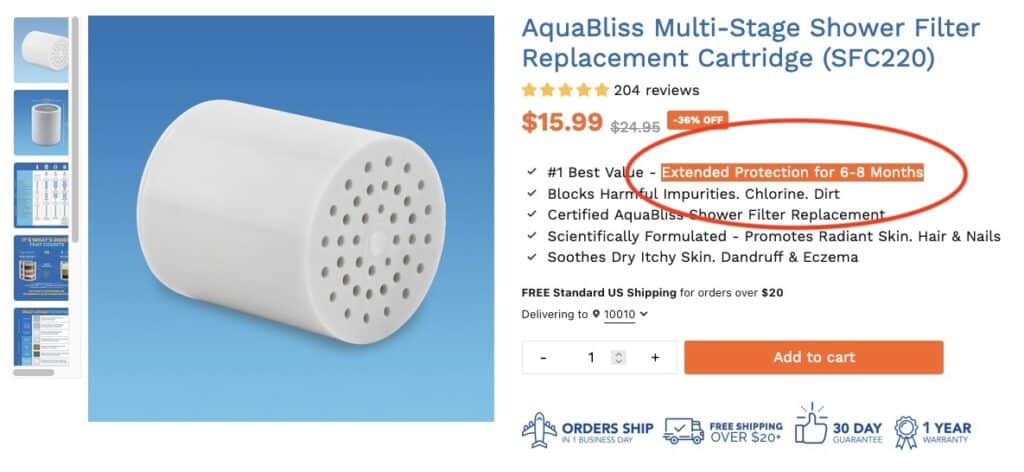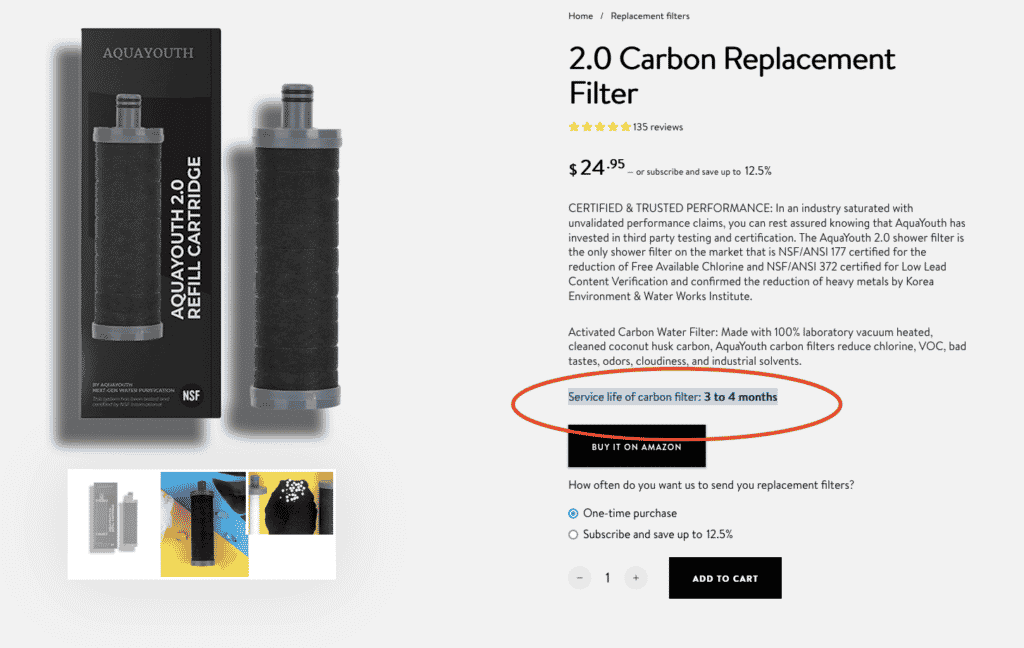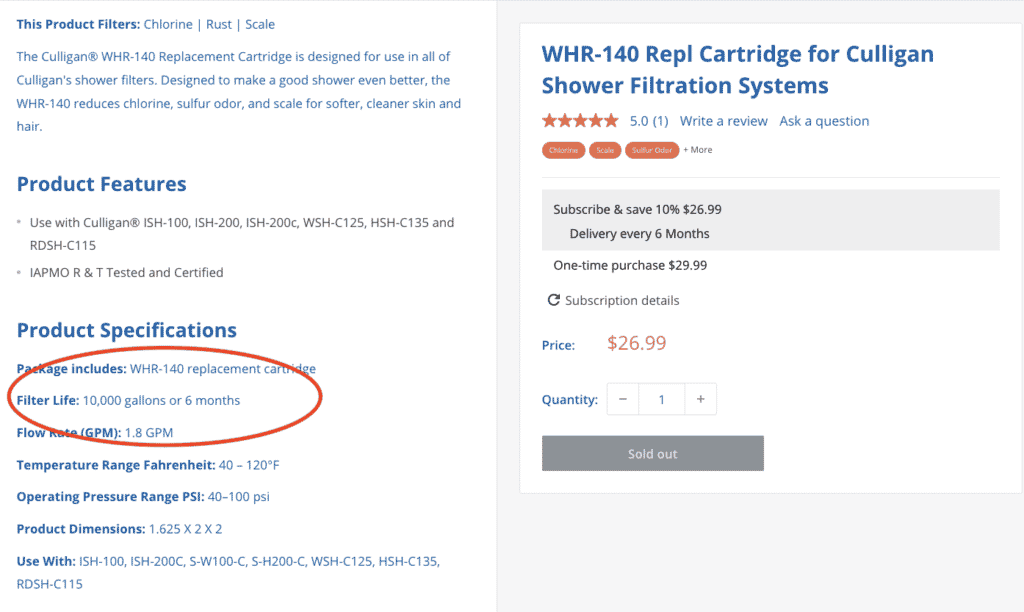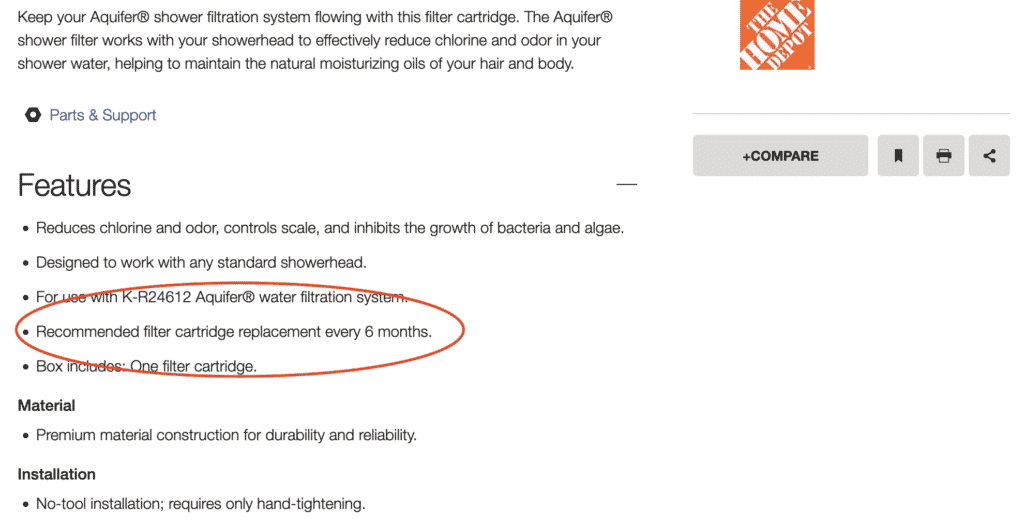To keep your shower water clean and free of harmful chemicals, it’s important to regularly replace your shower filter cartridge. Depending on the type of water in your area and how often you use your shower, you may need to replace your cartridge as often as every few weeks or infrequently as only twice per year.
Below we’ll share recommendations from popular brands, including Aquasana, AquaBliss, Culligan, Sprite, and others on when to replace your shower filter cartridge. We’ll also share some signs on when it may be time for a new cartridge.
How Often To Change These Shower Filter Cartridges (By Brand)
Here are the guidelines that many of the popular shower filter brands have for replacing their cartridges.
Summary Table
Here’s a brief look at when each brand recommends replacing their shower filter cartridge:
| Shower Filter Replacement Time Frame | How Often To Replace Cartridge (Months) |
|---|---|
| AquaBliss | 6 – 8 |
| Aquasana | 6 |
| AquaYouth | 3 – 4 |
| Culligan | 6 |
| Kohler | 6 |
| Sonaki | 1 |
| Sprite | 6 |
| T3 | 6 |
AquaBliss

AquaBliss’s shower filters are rated to last between six and eight months (source).
Aquasana

Aquasana’s flagship AQ-4100 shower filter should have the cartridge replaced every 10,000 gallons or about six months (source).
AquaYouth

The AquaYouth activated carbon shower filter has a modest three to four-month lifespan (source).
Culligan

Culligan shower filter, built into the showerhead, requires replacement once every six months (source).
Kohler

The Kohler Aquifer shower filter must be replace once every six months (source).
Sonaki

By far the shortest life, Sonaki recommend replacing their vitamin C shower filter once every four to six weeks (source).
Sprite

Sprite recommends that their inline shower filter be replaced once every six months (source).
T3

The T3 shower filter relies on a zinc, copper, and calcium sulfite media blend. This filter is recommended to be changed once every six months.
Signs Your Shower Filter Needs to Be Replaced
Whether you are uncertain of the brand or the last time you changed your filter, here are six signs that will help you know when it’s time for a new shower filter cartridge.
- Decrease in Water Flow: As your shower filter collects contaminants, it will begin to restrict water flow over time. This is one of the most common indicators that it’s time for a new filter.
- Odor: Many shower filters can remove foul smells naturally found in well water or city water supplies. Common smells include rotten eggs (from sulfur) or chlorine. If you notice a smell after a shower, especially one that emits quite a bit of steam, it’s likely time for a new filter.
- Color: If your shower water is discolored, typically with a brown tint, then it’s likely due to sediment or rust in your water. This is especially common if you have well water. A new shower filter will help to remove these contaminants and restore clarity to your water.
- Dry Skin or Hair: Whether it’s an uptick in dandruff, dry scalp, or your skin feeling tight and dry after showering, these can all be signs that the chlorine added to the water by your local municipality isn’t fully being removed. Shower filters can typically remove 90%+ of chlorine, so if you notice any of these gradual skin or hair changes, it may be time for a new filter.
- Soap Scum & Limescale: While shower filters aren’t the same as water softeners as they cannot remove hard water minerals, they may help to reduce the amount of soap scum and limescale buildup in your shower. Check the walls and around the drain of your shower. If you notice an increase in either of these, it may be time for a new filter.
- Unpleasant Taste: Aside from the smell, some people may notice an unpleasant taste when showering. This can sometimes be described as earthy, chemical-like, or metallic. Again, this is a sign that your filter isn’t doing its job and needs to be replaced.
Extend the Shower Filter Cartridge Life
Given the long-term costs associated with shower filters, some thrifty homeowners may be interested in ways to extend the life of their cartridges. There are a few things you can do to get more use out of your filter.
- Back Flush: This is where you take out your cartridge and install it in reverse. This will help to remove any sediment or contaminants that have become trapped on the surface of the cartridge. We recommend letting your shower run for several minutes so you aren’t bathing in this water that may have a higher concentration of contaminants. This may or may not work, depending on the model of your shower filter.
- Deep Clean: Another way to clean your cartridge is to remove it and soak it in a vinegar and water solution for about an hour. This will help to remove any buildup that may have occurred on the surface of the cartridge. After soaking, rinse it off with clean water before reinstalling it.
- Soften Your Water: When you install a whole house water softener, this will help to reduce the number of minerals in all the water that comes into your house, including your shower. In addition, the softer water that enters your shower filter will help to reduce the amount of sediment buildup within the unit itself.
- Lengthen the Time Between Replacement: Companies that make shower filters are in the business of making money. While they may recommend that you replace a filter every six months, the reality is that most filters can last a bit longer without any issue. Try swapping out the filter once every nine or twelve months and see how it goes. If you start noticing any of the issues listed above, you know it’s time for a new one.
Consider a Water Testing Kit
If you want to measure the purity of the water coming out of your shower, or perhaps you want to test for specific contaminants, then a water testing kit is a great option.
Containing several test strips, a water test kit allows you to see if the water you and your family are bathing in contains harmful chemicals or other contaminants, including:
- Arsenic
- Chlorine
- Mercury
- Copper
- Cadmium
- Bacteria
- Lead
- Nitrites/Nitrates
- Pharmaceuticals
- Pesticides
- pH levels
- Total dissolved solids (TDS)
If you notice any of the contaminants above in your water or any other concerns, you can consult with your local water authority or a water treatment specialist.
Conclusion
Shower filters are a great way to improve the quality of the water you and your family bathe in. We hope this guide has provided you with the information you need to make an informed decision about shower filters and how often to replace them. Check out our other guides for more helpful tips and advice.
